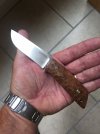soc_monki
Gold Member
- Joined
- Apr 5, 2019
- Messages
- 1,888
Spydercos caged ball bearing lock and compression lock are great. But if you're doing things that can cause a lock to fail get a fixed blade.
Still don't understand the spine whack tests...if the knife locks up solid and doesn't close when you try to force it you're good. Spine whacking will just damage the lock and possibly cause it to fail because it's been damaged.
Just my opinion.
Still don't understand the spine whack tests...if the knife locks up solid and doesn't close when you try to force it you're good. Spine whacking will just damage the lock and possibly cause it to fail because it's been damaged.
Just my opinion.

